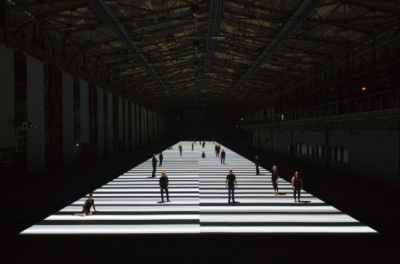 |
| Ryoji Ikeda, Test Pattern. |
I have seen a number of Ryoji Ikeda’s installations over the
years, and in this current one in the Grande Hall at La Villette he reaches a whole new level of creation, affect and meaning. On entering the
Grande Hall we hear a strange technically produced sound by which we are pulled
into the most spectacular of Paris’s former slaughterhouse spaces enclosed by a glass and cast iron structure. The visuals of the work laid out across the
floor of the hall are a highly complex “test pattern” in which Ikeda has
translated the everyday images that bombard and surround us into electronic form.
The result is a fluctuating series of black and white lines, bands, grids moving
unpredictably in a test pattern that is simultaneously hypnotic and slightly
disturbing. It is like stepping onto an enormous pulsating barcode. The
sound is likewise culled from the everyday and translated into a dramatic technobeat.
Together, the sound and image form a complete environment that envelops us, overwhelms us and simultaneously soothes us. To stand in the middle of this highly
structured chaos is like being in the middle of an endless ocean of sound and
images. Or, as my friend with whom I visited the installation remarked, it’s
like being on acid.
My visit to the piece was made even more compelling by a
young dancer who improvised a performance over the test pattern. His movements
were led by the sound and the light as they swept up and across the floor. Even non-professional dancers will intuitively move to the beat as they walk across and around the environment. Indeed, this physical engagement with
the light and sound is imperative because only then can we experience the
unpredictability of the music and light patterns. No sooner do we find the beat
than it changes. Ikeda’s work is this mix of the most sophisticated
mathematical computations, engineering design and an old-fashioned culling from
the popular cultural environment. What impressed me most was its appeal to
everyone: with the involvement of professional dancers, Sunday strollers, parents and children, old and young alike, this work unlike others of his I have seen
was a community event.
Across the hall is William Forsythe’s Nowhere and Everywhere at the Same Time no. 2. In this piece hundreds
of pendula hang suspended from the tracks of an automatic rig at ceiling height. We are invited to
enter the space and move among the pendula, but are warned not to touch or
disturb them. Until we are inside the forest of pendula we don’t realize that
it is actually very difficult to avoid the hanging weights. Because they constantly
change speeds and move in different, unpredictable directions. Presumably
through a computer designed algorithm, the pendula change the speed and arc of
their trajectory according to the shifting speed and direction of the tracks
above from which they are suspended. Thus, the experience is unsettling: we
begin casually strolling through the pendula, and then, suddenly their speed
changes and we have to run, jump, twist and contort our bodies to evade them. This
sense of their command over us created a kind of ominous feeling when inside
the installation. Watching others from the cast iron balcony above it was
possible to see how they evoked anxiety, a heart rush, panic, all in the attempt
to avoid touching them. There was literally nowhere to go dor refuge from
their predatory movements.
 |
| Forsythe inside Nowhere and Everywhere at the Same Time no. 2 Brighton Festival |
Once again, the inanimate objects dictate (not simply influence) the movement of the human body: we have no choice inside their system that is ungraspable to us. Forsythe as the vanguard choreographer is here committed to exploring the form and limits of human movement. And while it is fascinating to find see our bodies move in ways we do not expect if we follow the dictate of the pendula, it would also be interesting to see Forsythe himself dance inside the installation. Because it is on tour around Europe and has been to the US, there may still be opportunity to experience this.

No comments:
Post a Comment